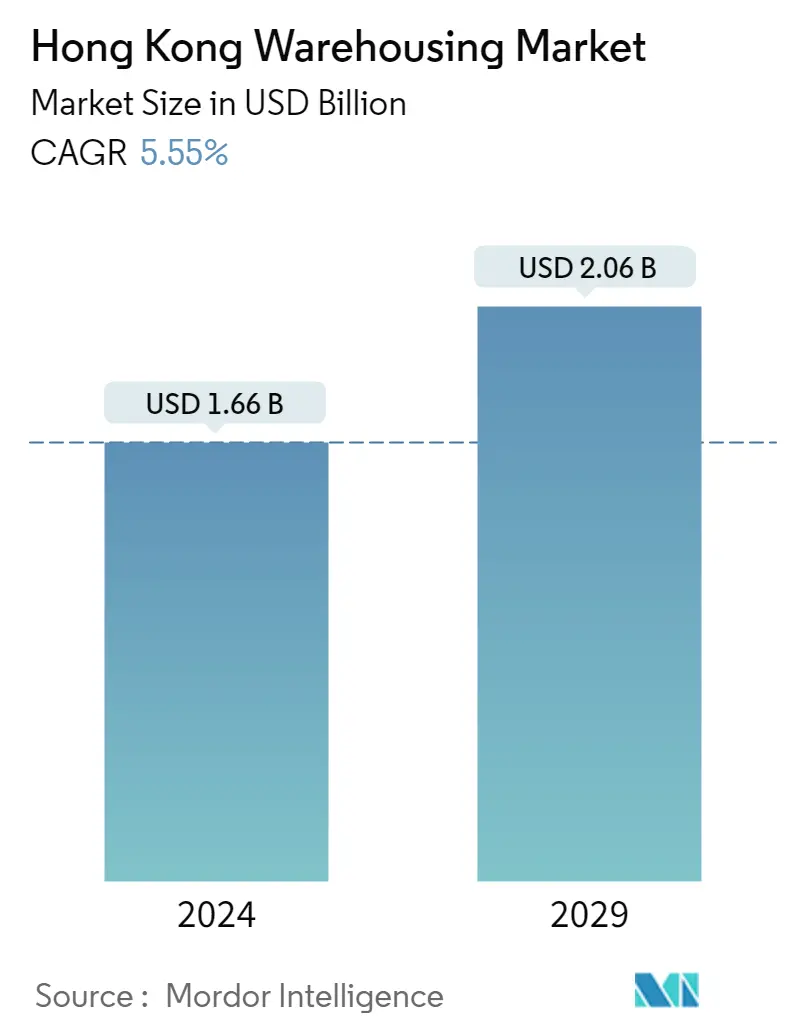Market Size of Hong Kong Warehousing Industry

| Study Period | 2024 - 2029 |
| Base Year For Estimation | 2023 |
| Market Size (2024) | USD 1.66 Billion |
| Market Size (2029) | USD 2.06 Billion |
| CAGR (2024 - 2029) | 5.55 % |
| Market Concentration | Low |
Major Players
*Disclaimer: Major Players sorted in no particular order |
Hong Kong Warehousing Market Analysis
The Hong Kong Warehousing Market size is estimated at USD 1.66 billion in 2024, and is expected to reach USD 2.06 billion by 2029, growing at a CAGR of 5.55% during the forecast period (2024-2029).
At the core of the global logistics industry, warehousing makes a significant contribution to the management and storage of goods. The warehouse market study shows that the comeback and growth of eCommerce changed the industry's intricacies, leading to an increase in demand for expedited responses and the ability to organize cargo inventory loads. The worldwide market will be ready for intelligent digital evolution, including the automation of a wide variety of operations, as the eCommerce sector grows. The features and operating approaches of potential warehouses will alter as a result of the logistics industry's increased propensity for digital transformation. The market is supposed to be stimulated by the rising need for an omnichannel retailing paradigm. Digitalization and process automation are continuously growing in the warehouse industry. It is expected to boost information flow across linked resources and coordinated business applications. Warehouse companies will be able to make data-driven decisions to maintain optimized resource utilization and the allocation and assessment of the appropriate operational benchmarks. It is to formulate a strategic plan for enhanced top and bottom-line development. It will be necessary for sustained advancement.
The increasing e-commerce and fierce regional rivalry are driving the warehousing business in Hong Kong to become more automated and effective. However, due to its extremely strict standards for logistics services, e-commerce will also hold a significant influence on Hong Kong's logistics sector. Researchers found that the magnitude of warehouse logistics required by e-commerce is three times greater than that required by the conventional retail sector. Large and diverse consumer bases are served by e-commerce, which generates a range of consumer needs. To best serve end users whose e-commerce orders are unpredictable with extremely high variety and variability (combinations of items with different types, quantities, sizes, shapes, weights, storage requirements (such as refrigerated), etc.), it remains a great challenge to offer appropriate warehousing services for warehouse users (WUs) (manufacturers, third-party logistics service providers, wholesale retailers, importers, exporters, etc.).
Additionally, the demand for warehousing services will rise quickly at peak times or holidays. Effective storage services are essential to ensure the timely and precise delivery of products. Advanced storage services are especially necessary for pricey overseas commodities to prevent damage.
Hong Kong Warehousing Industry Segmentation
Warehousing and storage services include storage space for companies' or organizations' property, including equipment, parts, products, and perishable goods. It often includes inventory management and distribution. The proper storage and tracking of inventory ensure delivery times are met and asset management costs are reduced.
The report offers the market sizes, trends, and forecasts in value for segments by type, ownership, end-user industry, and geography. The scope of the study also includes an in-depth analysis of COVID-19's impact on the warehouse and storage services market.
The Hong Kong Warehousing Market is segmented by type (general warehousing and storage, refrigerated warehousing and storage, and farm product warehousing and storage), ownership (private warehouses, public warehouses, and bonded warehouses), end-user industry (manufacturing, consumer goods, food and beverage, retail, and healthcare). The market size and forecast are provided in terms of value (USD) for all the above segments.
| By Type | |
| General Warehousing and Storage | |
| Refrigerated Warehousing and Storage | |
| Farm Product Warehousing and Storage |
| Ownership | |
| Private Warehouses | |
| Public Warehouses | |
| Bonded Warehouses |
| End-User Industry | |
| Manufacturing | |
| Consumer Goods | |
| Food and Beverage | |
| Retail | |
| Healthcare |
Hong Kong Warehousing Market Size Summary
The Hong Kong warehousing market is poised for significant growth, driven by the resurgence of eCommerce and the increasing demand for efficient logistics solutions. As a critical hub in the global supply chain, Hong Kong's warehousing sector is adapting to the complexities introduced by digital transformation and the need for rapid inventory management. The market is experiencing a shift towards automation and digitalization, enabling businesses to optimize resource utilization and enhance operational efficiency. This evolution is further fueled by the rise of omnichannel retailing, which necessitates advanced warehousing solutions to meet diverse consumer demands. The integration of intelligent digital technologies is expected to streamline operations, improve data flow, and support data-driven decision-making, thereby fostering strategic growth in the industry.
The competitive landscape of Hong Kong's warehousing market is characterized by a fragmented structure with numerous operators catering to various sectors, including electronics and frozen food/beverage industries. The demand for warehousing services is particularly pronounced during peak periods, highlighting the necessity for sophisticated storage solutions to ensure timely and accurate product delivery. The market is also witnessing advancements in refrigerated warehousing, driven by changing consumer behaviors and the surge in online sales of perishable goods. With Hong Kong's strategic location and access to major ports in East Asia, the region continues to be a vital player in international trade, offering extensive storage space and flexible customs clearance solutions. The ongoing developments in the warehousing sector, including the adoption of autonomous mobile robots and the expansion of cold storage facilities, underscore the dynamic nature of the market and its capacity to meet evolving logistical challenges.
Hong Kong Warehousing Market Size - Table of Contents
-
1. MARKET DYNAMICS AND INSIGHTS
-
1.1 Market Overview
-
1.2 Market Size and Demand Forecast
-
1.3 Recent Trends and Developments
-
1.4 Government Policies and Regulations
-
1.5 Drivers
-
1.5.1 Rise in E- commerce
-
1.5.2 Pharmaceutical Industry is driving the market
-
-
1.6 Restraints
-
1.6.1 Shortage of Skilled Labor
-
-
1.7 Opportunities
-
1.7.1 Technological Innovation
-
-
1.8 Value Supply Chain Analysis
-
1.9 Industry Attractiveness - Porter's Five Forces Analysis
-
1.9.1 Bargaining Power of Suppliers
-
1.9.2 Bargaining Power of Buyers/Consumers
-
1.9.3 Threat of New Entrants
-
1.9.4 Threat of Subsititute Products
-
1.9.5 Intensity of Competitive Rivalry
-
-
1.10 Impact of Covid 19 on the market
-
-
2. MARKET SEGMENTATION
-
2.1 By Type
-
2.1.1 General Warehousing and Storage
-
2.1.2 Refrigerated Warehousing and Storage
-
2.1.3 Farm Product Warehousing and Storage
-
-
2.2 Ownership
-
2.2.1 Private Warehouses
-
2.2.2 Public Warehouses
-
2.2.3 Bonded Warehouses
-
-
2.3 End-User Industry
-
2.3.1 Manufacturing
-
2.3.2 Consumer Goods
-
2.3.3 Food and Beverage
-
2.3.4 Retail
-
2.3.5 Healthcare
-
-
Hong Kong Warehousing Market Size FAQs
How big is the Hong Kong Warehousing Market?
The Hong Kong Warehousing Market size is expected to reach USD 1.66 billion in 2024 and grow at a CAGR of 5.55% to reach USD 2.06 billion by 2029.
What is the current Hong Kong Warehousing Market size?
In 2024, the Hong Kong Warehousing Market size is expected to reach USD 1.66 billion.

